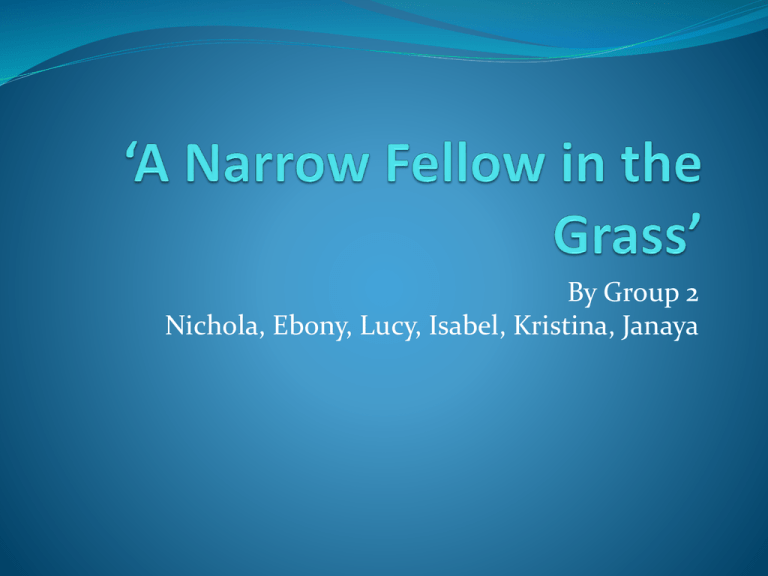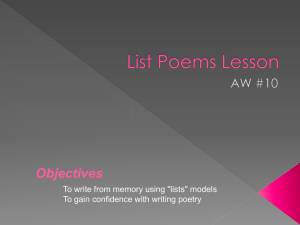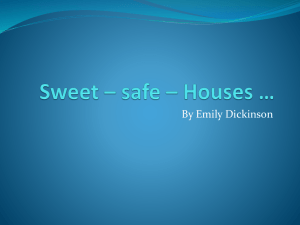A Narrow Fellow in the Grass` powerpoint
advertisement

By Group 2 Nichola, Ebony, Lucy, Isabel, Kristina, Janaya Reading the Poem A narrow fellow in the grass Occasionally Rides. You many have met him – did you not? His notice sudden is. The grass divides as with a comb, A spotted shaft is seen, And then it closes at your feet And opens further on. He likes a boggy acre, A floor too cool for corn; Yet when a boy and barefoot, I more then once at noon Reading the Poem Have passed, I thought, a whiplash Unbraiding in the sun; When, stooping to secure it, It wrinkled and was gone. Several of nature’s people I know, and they know me; I feel for them a transport Of cordiality But never met this fellow, Attended or alone, Without a tighter breathing And zero at the bone. Context Overview The” narrow fellow” can be interpreted as a snake; this notorious creature of nature is a long living symbol of treachery. As we know Dickinson is a fond lover of nature, and expresses this throughout most of her literature. The language and word choice from stanzas 3 – 6 shifts to words that come across that the feeling towards the snake has changed. Its shifted from being a fascinating creature, to be something impossible to love. This is one of Dickinson’s riddle like poems, questions are raised such as what appears to be and what is? The poem also explores the notion of an infant male being "hidden" in the grass, lines such as "you may have met him" and "did you not" invite the reader to be told of how he moves. The infant becomes frightened and uncertain of this creature that he thought once was a creature of no harm. The imagery of the boy being "barefoot" gives a sense that he is innocent and experiencing childhood imagination. It emphasises his sense of comfort with nature and how he belongs to the natural word. Structure A Narrow fellow in the grass is written in 6 stanzas each with four lines per stanza. This is similar to a folk/nursery rhyme, in it's repetition on rhythm and beat. “I more than once at noon” While these lines follow the basic meter of the poem, they produce a choppy affect because they are endstopped lines. This structure expresses the disjointed form of thought produced by Dickinson and the persona. Language Techniques In poem '127' Dickinson uses a variety of language techniques to portray meaning. The use of "fellow" throughout the poem is colloquial language, which is a form of not formal language, which indicates a connection between the persona and the snake. The snake is also personified throughout the poem with constant reference to "him" and "his" also showing the connection the persona feels to the snake, the creatures of nature are also referred to as "natures people" another use of personification to show the connection and perhaps sense of belonging the persona feels towards nature. Onomatopoeia is also used in poem "127" with the repetition of "s" used to mime the sound of the snake; this is evident in the line "a spotted shaft is seen" and in most stanzas of the poem. However, Dickinson also uses fear in the last stanza to show a ambiguous feeling towards nature with the lines "tightened breathing" and "zero at the bone" a recognition of death in nature, and that sometimes a connection cannot be made. Significant Quotes - A narrow fellow in the grass imagery, used to give the reader an image in their mind of the content of the poem (snake) - The grass divides as with a comb gives the reader an understanding about the snake, how it moves, provides greater depth and understanding on the subject for the reader - Unbraiding in the sun describes the snakes nature - Without a tighter breathing describes the feeling of fear that the persona experiences, explores the persona's emotions - I know, and they know me this quote shows that the speaker feels at one with the other presences in the poem, and enjoys the feelings of belonging to them and the reciprocity of their relationship Key Ideas on Belonging Poem reflects a strong sense of connection to nature, depicted by the environment (the field). Stanza 5 also reinforces persona's familiarity with her surroundings, thus demonstrating her sense of "belonging" with nature Sense of fear towards the "snake" conflicting with her love of nature, thus contradicting with her sense of identity Also, it is suggested that there is a sense of connection with the persona, and others who share a common fear of snakes. Providing a small sense of connection to others Alternatively, the snake in this poem is symbolic, representing irrational fears in all people. This anthropomorphism not only describes the nature of irrational fears, but also emphasises the mystery surrounding the nature of our fears. The common behaviour of people's fear creates a sense of connectedness between people, as they all share common reactions Links to Other Poems Dickinson’s poem, “A Narrow Fellow in the Grass”, can be said to be a comparison piece to another one of her famous poems called “Nature the Gentlest Mother”. Whilst “A Narrow Fellow” portrays the fierce and threatening side of nature through the fear of being confronted by the snake, the other poem, “Nature the Gentlest Mother”, looks at all aspects of nature as being sweet and nice, whether it be a gentle flowing river or Hurricane Katrina. She shows this fear when speaking of seeing the snake as a sudden shock, a “whip-lash”, and only ever refers to it through the use of similes and metaphors, as though the creature is too horrible to actually speak about. The structure of, not only these two poems, but in fact many of Dickinson’s poems, is a very noticeably clear aspect that links them together. Many of her poems, including: A Narrow Fellow”, “A Long Long Sleep”, “Nature the Gentlest Mother” and many others portray these structural similarities in their rhyming patterns, rhythm and the amount and lengths of the lines in each of their stanzas. Our Opinions On The Poem Ebony - The poem, to me only highlights dickinsons sense of belonging to nature and often the fear that comes with belonging. In most of her poems, we gain the understanding that she feels at one with nature and she feels that, that is where she belongs. The poem is very disguised and does not highlight to the reader that its about a snake, or young boy imagining a snake. I didnt really enjoy the poem. Lucy - I personally really didn’t like this poem upon first reading, and since studying it and analysing it a bit more in detail, I still don’t like it. It is overly cryptic and this makes it hard for the reader to make a connection with both the poet and the poets words/meaning. It does a good job of showing a sense of belonging between the boy and nature but that’s about it. Our Opinions On The Poem Nichola – This poem is difficult to understand and analyse due to its cryptic nature and disjointed phrases. Although it does portray Emily Dickinson’s key ideas on belonging , feelings of isolation and connectedness with nature. I did not enjoy this poem. It was hard. Isabel - I think this poem accurately portrays emotions associated with irrational fears. The persona is displays obvious respect for the object of her fear (in this case, the snake) as she feels most comfortable surrounded by nature. Her use of imagery to describe of the effects of an irrational fear (without a tighter breathing and zero at the bone) allow the reader to experience these feelings themselves. Overall, I think the poem is intriguing, however much of the poems meaning remains overly cryptic, which results in over analysis by others which I think, dilutes the actual meaning of the poem.









